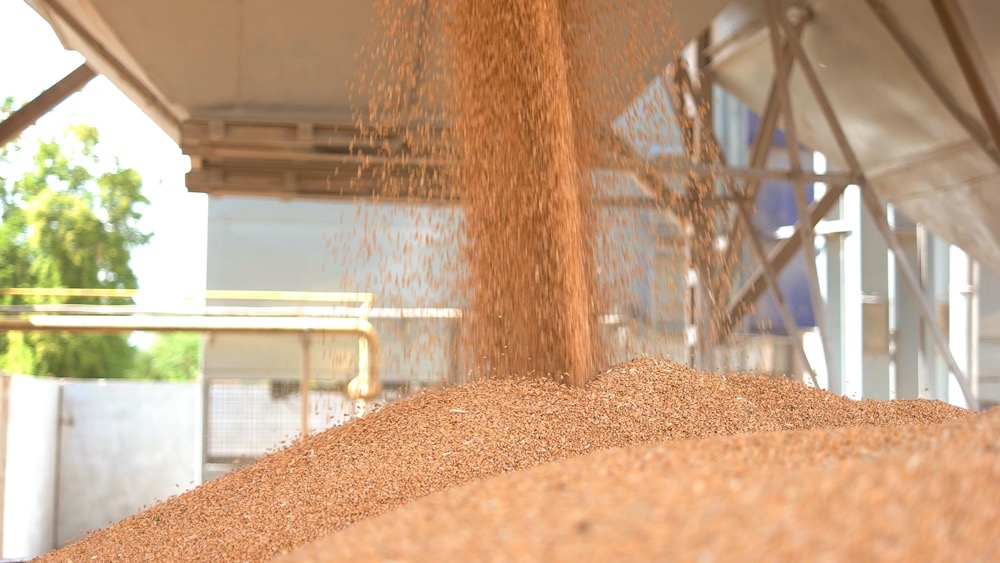Improper packing of bulk grain cargo can lead to the distortion of the container, compromising structural integrity, spillage of contents, contamination, and injury to workers when opening container doors, stresses Peregrine Storrs-Fox ,Risk Management Director of UK-based TT Club.
In the just-released TT Talk feature of the world’s leading transportation and logistics insurer, Mr. Storrs-Fox begins by noting that containers are an increasingly popular, cost effective method for the transport of bulk commodities such as grain. While there are efficiencies in transporting grain in containers, standard general purpose ISO containers are not designed to carry bulk cargoes, meaning additional procedures are required to do so safely.
What are the key risks?
- Distorted (bulged) containers can lose their structural compressive strength. When stacked on board ships or at container terminals there is an increased risk of stack collapse in extreme cases. Distorted containers can cause damage to a container ship’s cell guides and adjacent units, resulting in delays to cargo operations.
- Where false bulkheads and labelling have not been utilised, personnel opening and discharging the container may be crushed as the bulk cargo bursts out of the container upon opening the doors.
- Containers may be overweight or overloaded, given the dense properties of grain; capacity is restricted by mass rather than volume. The container, when fully packed with the cargo being transported, should not exceed the rated maximum gross mass of the unit (to ensure that it is not overloaded) as well as any intermodal weight restrictions applicable through the entire journey (when the unit would be overweight).
- Eccentric load distribution, most commonly caused through inappropriate filling operations but also potentially during rough intermodal movements or handling, can result in vehicle overturns or derailments.
- Grain cargoes spilt on board ships potentially result in significant problems for the ship’s bilge system. The associated clean up can be complex and costly.
- Pest contamination. Some pests, such as the Khrapra Beetle, can remain hidden in voids within the container for several years. Similarly, spillage during terminal handling operations or land transport is likely to attract birds and vermin, giving rise to health or injury risks.
- Contamination of the grain consignment from unclean container units, tainted by previous cargo residues and noxious materials.
Mitigating the risks
Much relies on the expertise of the shipper and packer to ensure that the container is adequately checked, prepared and filled/packed in line with industry guidelines to ensure the integrity of the cargo, the unit itself and general safety through the supply chain.
Under the IMO/ILO/UNECE Code of Practice for Packing of Cargo Transport Units (CTU Code), it is the responsibility of the shipper and packer to ensure that the container is suitable for the movement of grain and that the cargo is packed to withstand the rigours of transport.
Prior to packing
- Shippers should specify a dry bulk container, which then must meet or exceed standards similar to the ISO 1496 Part 4 specifications or equivalent that include additional end wall strength.
- Check the container to ensure it is free from signs of damage visible pest contamination or previous cargo residues. Pay attention to the condition of the container doors, floors, side panels and load capacity ratings. Where possible inspect the base structure. Any defects or concerns with the container should be discussed with the container operator.
- Securely attach a full bulkhead at the door end of the container to restrain the cargo and prevent pressure against the container doors. The bulkhead material should be timber or steel bars supporting compliant unbroken plywood or composite board.
- Consider installation of a plastic liner that encloses the cargo on at least five sides including the door end.
During packing/filling
- Ensure the process results in even load distribution of the cargo.
- If the cargo does not utilise the full volume of the container, it is important to ensure that the height of the cargo is kept constant throughout the container, minimising pressure on the side walls and reducing eccentricity.
- Ensure that the packing process does not give rise to an opportunity for pests to enter the container.
After packing/filling
- Each packed container must be weighed and certified prior to dispatching into intermodal transportation.
- At the end of the packing process, check the unit, including base structure, flooring and all supporting components, to ensure no distortion or leakage is evident or anticipated while in intermodal transportation.
- Determine that visible parts of both the interior and the exterior of the container, and the cargo, are free from visible infestation by pests.
- Affix an ISO 17712 compliant seal for international transport.
(Shutterstock photo shows grains discharging from a container)





